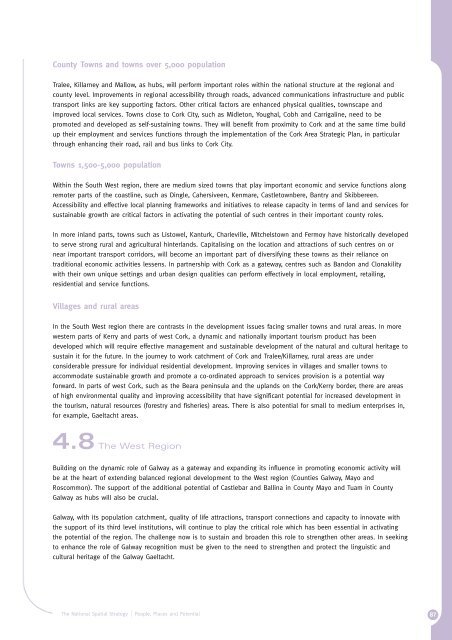National Spatial Strategy For Ireland 2002 - 2020 - Full ... - Kildare.ie
National Spatial Strategy For Ireland 2002 - 2020 - Full ... - Kildare.ie
National Spatial Strategy For Ireland 2002 - 2020 - Full ... - Kildare.ie
Create successful ePaper yourself
Turn your PDF publications into a flip-book with our unique Google optimized e-Paper software.
County Towns and towns over 5,000 population<br />
Tralee, Killarney and Mallow, as hubs, will perform important roles within the national structure at the regional and<br />
county level. Improvements in regional accessibility through roads, advanced communications infrastructure and public<br />
transport links are key supporting factors. Other critical factors are enhanced physical qualit<strong>ie</strong>s, townscape and<br />
improved local services. Towns close to Cork City, such as Midleton, Youghal, Cobh and Carrigaline, need to be<br />
promoted and developed as self-sustaining towns. They will benefit from proximity to Cork and at the same time build<br />
up their employment and services functions through the implementation of the Cork Area Strategic Plan, in particular<br />
through enhancing their road, rail and bus links to Cork City.<br />
Towns 1,500-5,000 population<br />
Within the South West region, there are medium sized towns that play important economic and service functions along<br />
remoter parts of the coastline, such as Dingle, Cahersiveen, Kenmare, Castletownbere, Bantry and Skibbereen.<br />
Accessibility and effective local planning frameworks and initiatives to release capacity in terms of land and services for<br />
sustainable growth are critical factors in activating the potential of such centres in their important county roles.<br />
In more inland parts, towns such as Listowel, Kanturk, Charleville, Mitchelstown and Fermoy have historically developed<br />
to serve strong rural and agricultural hinterlands. Capitalising on the location and attractions of such centres on or<br />
near important transport corridors, will become an important part of diversifying these towns as their reliance on<br />
traditional economic activit<strong>ie</strong>s lessens. In partnership with Cork as a gateway, centres such as Bandon and Clonakility<br />
with their own unique settings and urban design qualit<strong>ie</strong>s can perform effectively in local employment, retailing,<br />
residential and service functions.<br />
Villages and rural areas<br />
In the South West region there are contrasts in the development issues facing smaller towns and rural areas. In more<br />
western parts of Kerry and parts of west Cork, a dynamic and nationally important tourism product has been<br />
developed which will require effective management and sustainable development of the natural and cultural heritage to<br />
sustain it for the future. In the journey to work catchment of Cork and Tralee/Killarney, rural areas are under<br />
considerable pressure for individual residential development. Improving services in villages and smaller towns to<br />
accommodate sustainable growth and promote a co-ordinated approach to services provision is a potential way<br />
forward. In parts of west Cork, such as the Beara peninsula and the uplands on the Cork/Kerry border, there are areas<br />
of high environmental quality and improving accessibility that have significant potential for increased development in<br />
the tourism, natural resources (forestry and fisher<strong>ie</strong>s) areas. There is also potential for small to medium enterprises in,<br />
for example, Gaeltacht areas.<br />
4.8 The West Region<br />
Building on the dynamic role of Galway as a gateway and expanding its influence in promoting economic activity will<br />
be at the heart of extending balanced regional development to the West region (Count<strong>ie</strong>s Galway, Mayo and<br />
Roscommon). The support of the additional potential of Castlebar and Ballina in County Mayo and Tuam in County<br />
Galway as hubs will also be crucial.<br />
Galway, with its population catchment, quality of life attractions, transport connections and capacity to innovate with<br />
the support of its third level institutions, will continue to play the critical role which has been essential in activating<br />
the potential of the region. The challenge now is to sustain and broaden this role to strengthen other areas. In seeking<br />
to enhance the role of Galway recognition must be given to the need to strengthen and protect the linguistic and<br />
cultural heritage of the Galway Gaeltacht.<br />
The <strong>National</strong> <strong>Spatial</strong> <strong>Strategy</strong> | People, Places and Potential<br />
87
















